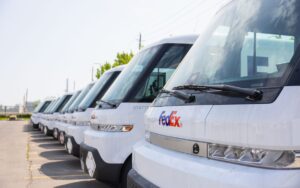The FedEx Canada ZEV fleet now consists of 50 battery-electric BrightDrop Zevo 600s, BrightDrop Trace carts and over 40 cargo e-bikes — with plans to add more as the supply chain permits

FedEx Express Canada unveiled the first 50 BrightDrop Zevo 600 delivery vans it has added to its fleet at its Toronto depot this week. Photo: FedEx
The FedEx Canada ZEV fleet now consists of 50 battery-electric BrightDrop Zevo 600s, BrightDrop Trace carts and over 40 cargo e-bikes — with plans to add more as the supply chain permits
FedEx Express Canada unveiled the first 50 BrightDrop Zevo 600 delivery vans it has added to its fleet at its Toronto depot this week.
The moment comes exactly one year after FedEx took delivery of its first Zevo 600s in the U.S. And just six months after the first BrightDrop van rolled off the assembly line at General Motors’ retooled CAMI plant in Ingersoll, Ont.
“FedEx Express Canada is proud of the role we’re playing to help our company work toward the goal of carbon neutral operations globally by 2040,” said Dean Jamieson, vice-president of operations at FedEx Express Canada, during the announcement.
“Working with companies like BrightDrop that are helping to build these solutions, right here in our own backyard, shows how Canada is helping to bring more sustainable solutions to life across a variety of industries.”
These first 50 BrightDrops in Canada are part of FedEx’s goal to achieve 50 per cent electric global pick up and delivery vehicle purchases by 2025. The company intends on rising to 100 per cent electric purchases by 2030.
FedEx already has 400 BrightDrops in service in California. The Canadian vehicles will divide between Montreal, Toronto and Surrey, B.C., with the majority operating out of the Toronto depot.
The vehicles have a range of 400 kilometres and are built 160 km away in Ingersoll.
If you build it they will charge
The key to FedEx Express Canada’s success, says Jamieson, in an interview with Electric Autonomy, is the preparation leading up to the BrightDrops arriving.
“We saw [charging infrastructure] as kind of a table stakes to get into it,” says Jamieson. “We’re competing with the rest of FedEx — and the rest of the world — for e-vehicles. So our mindset in Canada was, ‘If we have the infrastructure, then that hurdle is gone, so we will get the vehicles faster.”
It’s a strategy that’s paid off.
The overwhelming majority of FedEx’s electric fleet is in California. That three FedEx depots in Canada will now be operating zero-emission vehicles for the delivery company indicates the contemporary spin on the old adage is true: if you build it, they will charge.
To date FedEx Express Canada has installed 80 overhead chargers in its depots. The cost split between vehicles and chargers is, estimates Jamieson, 90/10, respectively.
The higher ratio of chargers to vehicles also signals there is more to come in the way of EV purchases. Jamieson says the plan is to move to electric as quickly as the supply chain permits.
Leveraging experience
One of the other valuable currencies on the strained commercial EV supply market is experience.
“The Canadian market has been very kind to us. We’re working with all the all the major players,” says Steve Hornyak, chief commercial officer at BrightDrop in an interview with Electric Autonomy.
“We’ve got probably a bigger pool than what we even had expected from Canadian companies for these vehicles.”
Jamieson says demonstrating to suppliers that their vehicle is going to end up in the hands of a company that knows how to operate and, to an extent, showcase it, is a valuable selling point.
“There are only so many manufacturers in the world and a lot of people that want these vehicles. And, for the manufacturers, it’s their name is on the vehicle,” says Jamieson.
“It’s important for us to be a strong business partner and show that capability from charge to charge. That’s really what we’re looking for going forward: that supply chain of vehicles and continuing to make us a vendor of choice as it relates to getting those vehicles.”
And since putting its first cargo e-bikes into service a few year ago and, more recently, the Zevo 600s and BrightDrop Trace electric carts, Jamieson says normal carrier routes are now acting as mobile billboards.
“The good side of the EV fleet here is public reaction. The public feedback, I think, has been that number one surprise of how much people notice it,” says Jamieson. “That kind of consumer reaction is probably not something we thought about upfront.”
Bringing the product to the customer
Though demand for the BrightDrop is high, market apprehension remains about vehicle capabilities and viability.
To put potential customers’ minds at ease, GM is facilitating product placement pilots.
“We have a fleet of test vehicles. So we actually bring a team out with test vehicles, let customers drive them for days to weeks and put them on a route so that [customers] can actually experience it themselves and get more confidence in it,” explains Hornyak.
From there it usually becomes a discussion about dollars and cents.
“I say it’s free — you just have to keep them long enough,” says Hornyak.
“You save (depending upon your cost of electricity) $1,000-$2,000 a month. It’s $10,000-$15,000 a year in operating cost savings on these vehicles. So, the return on investment is pretty fast.”
GM is also offering a stopgap portable charging solution for customers that aren’t installing infrastructure ahead of vehicle delivery.
And the top thing that can be done to make the commercial EV buyer climate more robust in Canada?
Hornyak is resolute: “Accelerate infrastructure. That’s number one through five. That is going to be the biggest item for fleets because you’ve got to get infrastructure for the buildings. They’re not going to charge on Tesla Superchargers. They’re gonna bring it back to the hub to slow charge overnight.”






